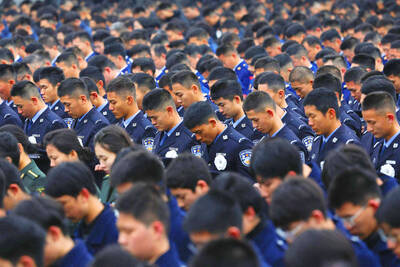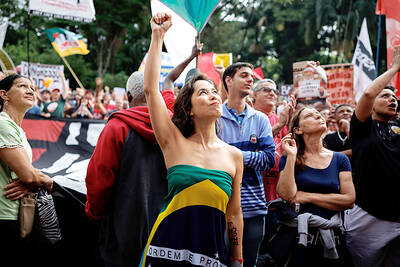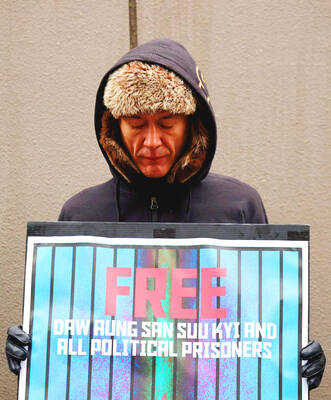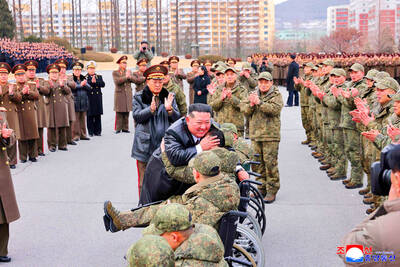Amid North Korea’s missile stand-off with the US, calls are mounting in South Korea for Seoul to build nuclear weapons of its own to defend itself.
The South, which hosts 28,500 US troops on its soil to defend it from the North, is banned from building its own nuclear weapons under an atomic energy deal it signed in 1974 with Washington, its security guarantor that instead offers Seoul a “nuclear umbrella” against potential attacks.
However, with Pyongyang regularly threatening to turn Seoul into a “sea of flames” — and nagging questions over Washington’s willingness to defend it if doing so put its own cities in danger of retaliatory attacks — the South’s media are leading calls for a change of tack.

Photo: Bloomberg
South Korea, which fought a war with the North that ended in a stalemate in 1953, is highly technologically advanced and analysts estimate it could develop an atomic device within months of deciding to do so.
“Now is time to start reviewing nuclear armament,” the Korea Herald said in an editorial yesterday.
After Pyongyang conducted two successful tests of intercontinental ballistic missiles last month, putting much of the mainland US within reach, the newspaper said: “Trust in the nuclear umbrella the US provides to the South can be shaken.”
It urged Washington to deploy some of its atomic weapons to South Korea if it did not want to see a nuclear-armed Seoul.
The US stationed some of its atomic weapons in the South following the 1950 to 1953 Korean War, but withdrew them in 1991 when the two Koreas jointly declared they would make the Korean Peninsula nuclear-free.
However, Pyongyang carried out its first nuclear test in 2006 and formally abandoned the deal in 2009.
Tensions have soared in recent months with US President Donald Trump this week warning of “fire and fury” against Pyongyang, which threatened missile strikes near the US territory of Guam.
The North’s military chief Ri Myong-su responded saying that if the US continued in its “reckless” behavior, Pyongyang would “inflict the most miserable and merciless punishment upon all the provokers.”
The latest war of words between Trump and the North — ruled by Kim Jong-un — unnerved many in the South, even though it has become largely used to hostile rhetoric from its neighbor.
A conflict between the North and the US could have devastating consequences for Asia’s fourth-largest economy, with Seoul within range of Pyongyang’s vast conventional artillery forces.
“A catastrophe is looming,” the South’s top-selling Chosun daily said in an editorial this week. “All options, even those considered unthinkable so far, must be on the table.”
In all the North has staged five atomic tests — including three since Kim took office — as it seeks to develop a nuclear-tipped missile capable of hitting the continental US.
A survey last year — even before tensions began to mount — showed that about 57 percent of South Koreans already supported the idea of nuclear armament, with 31 percent opposing it.
“We need to have our own military options to overwhelm the North,” the Korea Economic Daily said in an editorial this week, calling for nuclear weapons to ensure a “balance of terror” and prevent Pyongyang from attacking the South.
However, a South Korean bomb would infuriate Pyongyang, which says it needs nuclear weapons to defend itself against the threat of invasion, and make bringing it to the negotiating table even harder.
South Korean Minister of National Defense Song Young-moo said recently that the South was “fully capable” of building its own nuclear weapon, but was not considering the option for now.
Atomic arms are not the only way Seoul can step up its defenses.
Song is pushing for the development of nuclear-powered submarines, although doing so also requires consent from the US.
South Korean President Moon Jae-in has also urged limits on Seoul’s missiles to be increased in a conversation with Trump.
At present, Seoul is allowed to possess ballistic missiles with a range of 800km and payload of 500kg. It wants the weight limit raised to 1,000kg.
The Pentagon on Monday said it was “actively” considering the revision.

China yesterday held a low-key memorial ceremony for the 1937 Nanjing Massacre, with Chinese President Xi Jinping (習近平) not attending, despite a diplomatic crisis between Beijing and Tokyo over Taiwan. Beijing has raged at Tokyo since Japanese Prime Minister Sanae Takaichi last month said that a hypothetical Chinese attack on Taiwan could trigger a military response from Japan. China and Japan have long sparred over their painful history. China consistently reminds its people of the 1937 Nanjing Massacre, in which it says Japanese troops killed 300,000 people in what was then its capital. A post-World War II Allied tribunal put the death toll

‘NO AMNESTY’: Tens of thousands of people joined the rally against a bill that would slash the former president’s prison term; President Lula has said he would veto the bill Tens of thousands of Brazilians on Sunday demonstrated against a bill that advanced in Congress this week that would reduce the time former president Jair Bolsonaro spends behind bars following his sentence of more than 27 years for attempting a coup. Protests took place in the capital, Brasilia, and in other major cities across the nation, including Sao Paulo, Florianopolis, Salvador and Recife. On Copacabana’s boardwalk in Rio de Janeiro, crowds composed of left-wing voters chanted “No amnesty” and “Out with Hugo Motta,” a reference to the speaker of the lower house, which approved the bill on Wednesday last week. It is

The Burmese junta has said that detained former leader Aung San Suu Kyi is “in good health,” a day after her son said he has received little information about the 80-year-old’s condition and fears she could die without him knowing. In an interview in Tokyo earlier this week, Kim Aris said he had not heard from his mother in years and believes she is being held incommunicado in the capital, Naypyidaw. Aung San Suu Kyi, a Nobel Peace Prize laureate, was detained after a 2021 military coup that ousted her elected civilian government and sparked a civil war. She is serving a

FALLEN: The nine soldiers who were killed while carrying out combat and engineering tasks in Russia were given the title of Hero of the Democratic People’s Republic of Korea North Korean leader Kim Jong-un attended a welcoming ceremony for an army engineering unit that had returned home after carrying out duties in Russia, North Korean state media KCNA reported on Saturday. In a speech carried by KCNA, Kim praised officers and soldiers of the 528th Regiment of Engineers of the Korean People’s Army (KPA) for “heroic” conduct and “mass heroism” in fulfilling orders issued by the ruling Workers’ Party of Korea during a 120-day overseas deployment. Video footage released by North Korea showed uniformed soldiers disembarking from an aircraft, Kim hugging a soldier seated in a wheelchair, and soldiers and officials